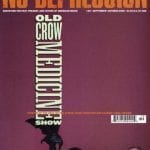Welcome to Macondo
In his Nobel acceptance lecture, novelist Gabriel Garcia Marquez asserted that the magical realism that characterized life in Macondo in One Hundred Years Of Solitude wasn’t that magical. “We have had to ask but little of imagination,” he said. “Our crucial problem has been a lack of conventional means to render our lives believable. This, my friends, is the crux of our solitude.”
It is as difficult to let people know what it’s really like here. How do you talk to people about sitting under the Claiborne overpass with Antoinette K-Doe and her friends with a graveyard of flooded, abandoned cars behind you as you wait for Usher to show up because he “adopted” the renovation of K-Doe’s Mother-in-Law Lounge? How do you talk about living in a city with potholes so deep they hide shopping carts?
Who’d believe Allstate could report second-quarter profits of $1.21 billion and try to drop wind and hail coverage in eighteen coastal parishes? Who’d believe that ten months after Katrina, mayor Ray Nagin has a third scheme to rebuild, calling for 73 neighborhood committees to develop plans? Who’d believe we’re not sure where to evacuate to if another hurricane heads our way? Nagin announced that seniors would leave town by train — news to Amtrak officials.
Who’d believe that the country’s president has been almost completely absent from the rebuilding effort? It would be nice to be able to identify something concrete he has done — positive or negative — to comment on the federal response a year after Katrina, but there’s nothing.
It is a remarkable experience to live in a city after a hurricane, but I can’t recommend it. A look at a city’s inner workings reveals how fragile it is; break a bond and it’s scary to see how quickly things get ragged. The city laid off staff after the hurricane, but now business leaders complain that plans for development and new construction are threatened by backlogs in the City Planning Commission and Safety and Permits Department. The fire department is shorthanded and water pressure is weak from pipe damage, so French Quarter residents have grown used to the sight of helicopters flying buckets of water overhead.
Emotions are still heightened. A friend is leaving town because she’s tired of crying after reading the paper each day. I’ve choked up to songs I never thought would affect me emotionally. How do you explain tearing up to Keith Urban’s “Days Go By” at Jazz Fest? How do you communicate to people what it’s like to live afraid to make decisions because you don’t trust your emotions? How do you let people know what it’s like not to be able to make plans? Everything more than a month away from right now feels contingent upon so many unspoken ifs that it’s impossible to view any future as more than a dim mirage. Without plans, however vague, you’re stuck in an uncertain present watching the weeds grow knee-high in front of the house three doors down that has been abandoned since the hurricane.
In that present, you discover nothing is quite like you left it last August 28. Most businesses are still short-handed and short on income, so coffee shops and stores you’ve known for years are open two fewer hours, hours you never think about until you need them. Many gas stations closed after Katrina and haven’t reopened, but you never think about where gas stations are until you’re low, and then you remember that those in Mid-City, Gentilly, Lakeview and the Lower Ninth Ward haven’t reopened, nor have some in Uptown. ATMs are also harder to find, and the parts of town that don’t have them likely don’t take credit cards, either. These are little things, but in an emotionally fragile place, they’re painfully destabilizing.
At least people recognize this story needs telling. Two of the first Katrina books are Douglas Brinkley’s The Great Deluge and Jed Horne’s Breach Of Faith, both of which are good places to start. Brinkley’s book has a barely controlled rage that is unusual in a history, but it gives the book a live, cathartic quality. Horne’s book is more measured as he tells the story of people from all walks of life during and after the storm. He describes women jumping from roof to floating roof in the Lower Ninth Ward flooding, and he shines light on little-known parts of the story such as life in the Bywater after Katrina. Spike Lee’s four-part HBO documentary When The Levee Broke gives the events the operatic feel they merit. Still, the constant examination of our wounds makes me feel like one of Jerry’s Kids at times.
It doesn’t matter if the cameras are on or off, though. We reflect on Katrina. Conversations may be about one thing, but the hurricane’s literal and metaphorical gravity pulls us back. One Saturday afternoon in June, three guys in a bar revisited August 29, one remembering watching WWL-TV online and the other insisting that the BBC’s coverage was much better. A month later, a few people in a coffee shop were reliving the days after Katrina with Robert Rue, the guy who painted “Don’t try. I am sleeping inside with a big dog, an ugly woman, two shotguns and a claw hammer” on the side of his store.
Gabriel Garcia Marquez addressed this phenomenon as well. In Chronicle Of A Death Foretold, he wrote, “The cocks would catch us trying to give order to the chain of many chance events that had made absurdity possible, and it was obvious we weren’t doing it to clear up any mysteries but because none of us could go on living without an exact knowledge of the place and the mission assigned us by fate.”




